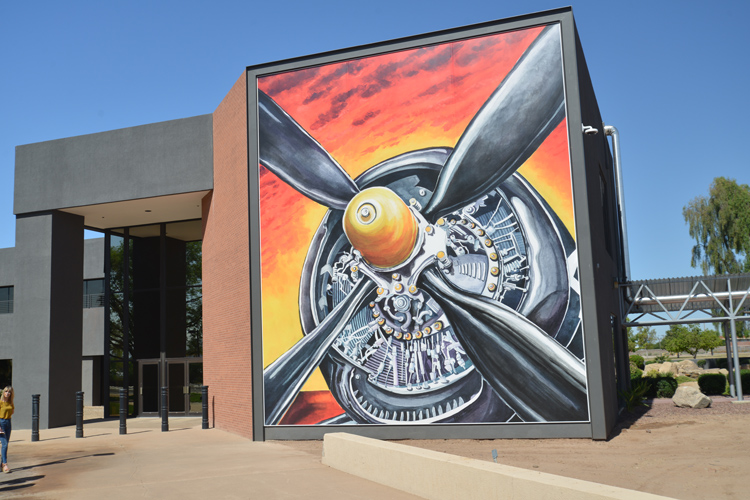Movies such as “My Fair Lady,” “Grease,” “Can’t Buy Me Love,” and “Clueless,” all share the common theme of misunderstood perceptions. In some cases, central characters were perhaps unfairly branded. In other instances, protagonists were presented with a catalyst to ultimately help them become who they were always meant to be. In any case, the viewer gets to witness a dramatic transformation. A similar plot has been unfolding in West Valley.
Long perceived as a manufacturing distribution hub, the West Valley has transformed into a progressive, competitive, and lucrative hotspot of burgeoning innovation, ready-made professional talent and quality of life perfectly suited for those seeking a small-town feel with the amenities of a big city.
“Our primary challenge in the West Valley for several years has been an outdated perception issue about our demographics and quality of life,” says Jeanine Jerkovic, economic development director for the City of Surprise. “This is beginning to change the more that people continue to move to the West Valley and experience the youth and vibrancy for themselves.”
Team approach
The change in perception of the West Valley is also shifting thanks to the aggressive work of WESTMARC, in collaboration with West Valley public and private partnerships, combined with city-led synchronicity. These local forces have taken the challenges of a much overdue makeover head-on. CBRE, for example, recently partnered with WESTMARC to create a joint-marketing piece to help eliminate antiquated ideas surrounding the West Valley.
The result — concrete statistics that reveal the current economic opportunities, household earning potential and labor supply advantages. For example, one of the tired branding misconceptions about the West Valley has been a lack of professional services labor. Now, with proof that 35 percent of Metro Phoenix’s healthcare workers, 32 percent of finance and insurance workers, and 35,000 computer science and IT programming laborers reside in the West Valley, dated perceptions are diminishing.
To help the West Valley progress further in her modern makeover, there’s still more work to be done.
“We need to focus on attracting office space construction,” says Sintra Hoffman, WESTMARC’s president and CEO. “We need to have existing Class A office space to step up our game in attracting users in the areas where we already have the workforce to support them.”
According to Hoffman, research demonstrates that the West Valley needs more build-to-suit Class A product. “Companies want existing office space, so from an economic development standpoint, we need to mitigate the risk for developers in order to make the investment in office space.”
In the works in the West Valley
Projects such as the recently slated Goodyear Civic Square located north of McDowell Road and west of Harkins Theater near 150th Drive are a step in the right direction. With plans to include several features — including a city hall, library, two-acre park and gathering place, and an upscale Class A office complex — the Goodyear Civic Square is exactly what the West Valley needs to attract more users.
“This is an important milestone for the city’s future growth,” said Lori Gary, Goodyear’s economic development director. “Class A office space is lacking in the West Valley, limiting our ability to vie for these desirable office projects. Goodyear will now be able to compete to attract high-end office users, which will bring even more high-quality jobs to the area.”
In addition to shovel-ready office space, the West Valley needs startup investors to level-up, according to Ron Babich, CEO and founder of EasyVoice Voice Platform and chairperson of the West Valley Innovation Alliance.
“We see interest from several tech startups interested in establishing roots in the West Valley,” Bacich says, “but we really need an incubator program to attract investors.”
That’s where entities like the West Valley Innovation Alliance (WVIA) and AZ TechCelerator (City of Surprise) have stepped in. Together, with support from local higher education entities, they advocate for more opportunities for growing West Valley professional talent, and fewer reasons for them to have to commute to East Valley jobs.
As Babich humorously, but accurately puts it, “The West Valley may have 99 problems, but tech resources ain’t one. We have the talent and 40 percent of the workforce,” he says, “but we need to continue to build more faith in the system for investors.”
Remarkable resources
Part of eliciting faith is revealing additional resources above and beyond a solid available workforce.
“The AZ TechCelerator launched 10 years ago as a creative reuse of the City of Surprise former City Hall facility,” says Jerkovic. “It was a different time economically in Arizona then, and the team in Surprise knew we had to energize our own local economy by helping start-up companies and ensure a long-term economic future.”
From there, Jerkovic and her City of Surprise cohorts pivoted their economic development strategy from a primary focus on attracting larger corporate investments to a more balanced one, focused on building a strong local entrepreneurship and small business ecosystem.
The key, Babich says, “is more awareness of the tech the West Valley already has.”
Babich provides examples, which include:
• EasyVoice: Makers of voice software for hands-free time sheets in all industries and medical patient management in healthcare.
• InstantHandz: Software that helps neighbors connect jobs to assist other neighbors.
• LeadFuze: Software that helps businesses find new leads.
• RTA Fleet Management: Fleet management software.
• Promineo Tech: World-class education and student experience through quality programs, service focused interactions and working to make skills in technology available, accessible, and affordable to everyone.
• Savant WMS: Warehouse management software.
• Bravo Pay: Cashless tipping app for mobile devices.
“The West Valley is essentially a nearly-untapped workforce mega-center for the region, anchored by several growing universities such as Ottawa and Grand Canyon Universities as well as vocational, CTE programs at West-MEC, Estrella Mountain Community College, Rio Salado and Dysart Unified School District,” Jerkovic says. “With several major data centers coming online in the West Valley, tech businesses can also be reassured that their data storage, fiber and telecom needs will be met.”
In fact, AZ TechCelerator is currently helping global companies launch and is the only innovation hub in Arizona to receive the International Business Incubation Association “Soft Landing” designation, which is only one of 31 worldwide.
It’s not simply West Valley startups, that need nurturing. “We have to take tech seriously. One of the things that I learned as part of growing a region infrastructure, is that technology is an essential requirement,” Babich explains.
As more office space, tech startups, FinTech, healthcare and additional professional services migrate West, they’ll be happy to know they have reached the West Valley in the prime of her makeover — fresh-faced and ready to take on new adventures.
West Valley’s key industries
Healthcare: 1,412 businesses, 46,300 employees
Warehouse and distribution: 910 businesses, 42,140 employees
Manufacturing: 646 businesses, 31,320 employees
Finance: 559 businesses, 22,070 employees
Aerospace: 83 businesses, 5,230 employees
Information technology: 71 businesses, 3,360 employees




